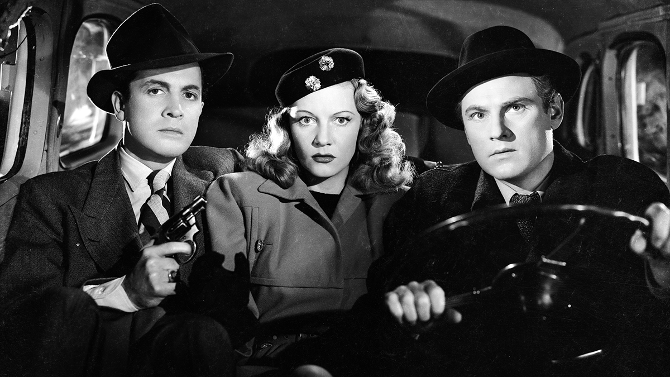Taking the rare angle of having the femme fatale be the voice-over narrator, the 1946 film noir Decoy, directed by Jack Bernhard, does a lot with the little budget it had.
Perhaps the most brutal dame of them all, Margot Shelby (Jean Gillie) is shot at the very beginning of the story, wounded by a then unknown assailant. It is at this point that she recounts her sordid tale.
Honey to a rough and tumble aging gangster, Frankie Olins (Robert Armstrong), the man has been placed behind bars following a robbery – which left a guard dead and the thief four hundred thousand dollars richer (which he hid before he got caught). Soon to be sent to the gas chamber, he still has hope that his girl, along with a gangster associate, Jim Vincent (Edward Norris), will find a way to help him escape his doomed fate. Vincent, already short tens of thousands in aiding his fellow hoodlum, is not eager to throw more dough his way.
Shelby, whispering sweet nothings into both of their ears, devises a plan in which they use a doctor by the name of Craig (Herbert Rudley) to resuscitate the jailbird shortly after his demise. Somewhat surprisingly, things go off without a hitch, until they decide to kill the man right after he has drawn a map to the money’s hidden locale. Suddenly, a copper by the name of Joe Portugal (Sheldon Leonard) just happens to knock on the doctor’s door soon after the murder. What will become of Shelby, the edgy Vincent and the pained doctor (who has twisted himself to pieces following his disobedience of the Hippocratic oath)? Will any one of them be able to escape with the money?
At the heart of the story is the rich character of Margot Shelby – a woman more cunning, ruthless, violent and seductive than perhaps any other femme fatale. She wraps each man around her little finger with her intoxicating British lilt, hourglass figure and over-abundance of eroticism. Though even more jarring is her penchant for violence – never getting cold feet when the opportunity arises for her to advance her position a little further.
The way in which the movie came to be is quite intriguing. Novelist Stanley Rubin (who wrote the book), originally sold the tale for radio, though soon saw film as another avenue to pursue. Selling the story to Jack Bernhard of Monogram Pictures, the studio is part of what was known as poverty row – a group of studios that made cheap, B-grade flicks. Bernhard, originally a small time producer, joined the war effort (World War 2), where he met a British actress by the name of Jean Gillie. Falling madly in love, he married her, and they returned to Hollywood after the end of the war. Looking for a vehicle for her to become a star, he produced and directed Decoy. As work on the picture was wrapping up, she left him, but died of pneumonia not too long after at the age of 34 (making only one other movie in the States). This sad story, mixed with her fascinating performance as the unscrupulous character, has given the film a cult status within the very cult realm of film noir.
Though there are definitely some flaws with this flick, it grows more mesmerizing as it takes hold of you. Finding strength as its seamy story grows, it is spellbinding to watch a dame who is truly only interested in the dough be able to multitask – ensnaring the senses of several men who are in love with the idea of having both the woman and the cash. Critic Glenn Erickson, a fan of the film, compared it to something Quentin Tarantino (Pulp Fiction) would have done back in the 1940s. This can clearly be seen – as the strong woman, abrupt violence and twisty delivery all ooze that Tarantino-esque vibe. So, don’t feel like you have to double cross anyone to check out this obscure tale of sin and greed; hopefully, you’ll be able to dig this one up and find what you like inside.

